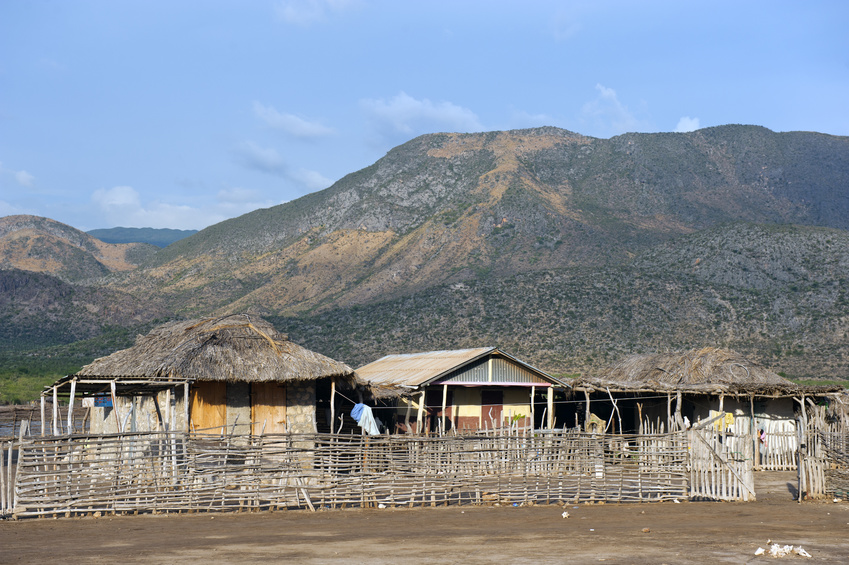Part 1 of this post addressed the issue of global energy poverty in rural areas: its implications, challenges, and promising developments in African nations and in India. Part 2 addresses off-grid problems in Haiti, potential microgrid solutions in Alaska, and the population-empowering “Minigrid Game.”
Haiti struggles with extreme energy poverty
Haiti is the poorest nation in the Western Hemisphere. Seventy-five percent of Haitians lack electricity access and must cook and light their homes with potentially deadly — and expensive — fuels like kerosene. However, some exciting projects are underway in this Caribbean nation that address the country’s energy poverty.

Traditional living in poverty-stricken rural Haiti
Non-profit organization EarthSpark and its Haitian social enterprise spin-off, Enèji Pwòp (which means “clean energy” in Haitian Creole), created Haiti’s first solar-powered, prepaid microgrid, which offers a model that scaled up can electrify rural areas not only in Haiti but in other developing countries. The Les Anglais microgrid offers efficient electricity use, renewable generation, battery storage, and smart-meter technology.
The new system provides energy access, which is revolutionizing this town’s large agricultural sector with its cost-effective and non-polluting energy. Last year, EarthSpark and Enèji Pwòp announced a joint commitment to build 80 microgrids in Haiti by the end of 2020.

EarthSpark’s ‘town-size, solar-powered, smart grid’ is the first of its kind in Haiti (photo caption)
“Electricity in and of itself is useless,” writes EarthSpark president Allison Archambault. “It’s what one does with each watt-hour that is truly transformative.” She adds: “We build value chains that bridge the gulf between the community and their access to energy,” offering both light and power needed to run local businesses.
Georgia Tech students install microgrid, plan more, to combat global energy poverty
“In rural communities like Thoman where the majority of Haitians live,” says Georgia Tech’s Frank Lambert, the energy poverty “problem is even more challenging because it can be difficult and expensive to reach grid power.” Lambert is the faculty advisor to Georgia Tech’s IEEE Power & Energy Society (PES) Student Chapter, which in May installed a microgrid system for a new healthcare facility providing health and dental care for the more than 4,000 people living in and around Thoman.
The IEEE PES Student Chapter plans to build upon this project and develop a similar power generation and distribution system for another healthcare facility in Galette Chambon, Haiti, next year.
A path to prosperity for rural Haitians
For Sigora Haiti, a subsidiary of Virginia-based Sigora Solar, wind and solar microgrids provide a path to prosperity for rural Haitians. Sigora Haiti began with the vision of electrifying a clinic, but its plans to bring clean, reliable, affordable energy to Haiti have now grown exponentially.
“Since starting our pilot project in Mole St. Nicolas, Haiti on December 21 [2015],” the company says, “we have built from scratch a grid with over 100 activated clients who are buying power.” These clients range from an ice-cream shop to TV and radio stations to a clinic serving 10,000 people. Sigora Haiti plans to bring microgrid-based electricity to 2 million people by 2025.
Microgrid boom on America’s “last frontier” helps address global energy poverty
As the U.S.’s most remote state — with an extreme climate to boot — Alaska is a fertile breeding ground for microgrid technologies that can benefit rural areas in the developing world. These regions share similar issues as the state: long (and vulnerable) supply chains, expensive and unpredictable fossil fuel costs, and rugged conditions. If you can make it work in Alaska, the saying goes, you can make it work anywhere.
And it’s working. According to Navigant Research, Alaska is likely to have a $300 million share of the $5.8 billion global microgrid industry projected for 2023. Already, Alaska’s microgrid system, with a capacity of more than 800 MW, is the world’s largest. The University of Alaska’s Global Applications Program is committed to sharing the state’s knowledge and experience with the developing world.

Wind turbines help Kodiak Island go 100% renewable energy.
In the past ten years, state and federal initiatives have invested hundreds of millions of dollars in Alaska’s microgrids. In addition, Alaska’s state government has now set a goal of 50% renewable energy by 2025. Alaska currently has more than 200 microgrid projects, according to Cady Lister, lead economist at the Alaska Energy Authority.
Last year, President Obama announced a number of federal initiatives focused on microgrids, including a $4 million competition to help remote Alaska communities develop sustainable energy plans. More recently, the Energy Department announced $7 million in funds for energy program assistance and training for Alaska’s Native American communities and tribes.
In January, the U.S. Department of Energy (DOE) launched a $1 million Alaskan R&D project in Alaska to increase remote grid reliability and decrease its diesel reliance by 50%. Other recent initiatives include a $250,000 grant to the Alaska Emerging Technology Fund and a $500,000 matching grant to the Alaska Center for Microgrid Technologies Commercialization.
The State Department is working on an “Arctic Renewable Energy Atlas” designed to help other Arctic communities with their renewable energy projects.
“We also want to find ways to share technical, financial and policy best practices” with other rural areas around the Arctic, says Sydney Kaufman, foreign affairs officer for Arctic Energy Security.
DOE has authorized $1.2 million in funds to design a microgrid control system on St. Paul Island. Kodiak Island is already operating on almost 100% wind and hydro energy. In fact, so much is happening in the Alaskan microgrid landscape that these are only examples of the many projects in the planning stages or currently underway on America’s “last frontier.”
“Alaska is home to 12% of the world’s microgrids powered by renewable energy systems,” writes Gwen Holdmann, director of the Alaska Center for Energy and Power, “and has more than 2 million hours of continual operating experience for these types of systems. Over 100 small businesses, as well as the Alaska Center for Energy and Power, have gained expertise in this sector and are now venturing out to test global markets for renewably-powered microgrids. Alaskans are now working in such far-flung locations as the South Pacific, Antarctica, and Africa.”
“Everyone should start by playing games”
This 2-part post has covered a wide array of projects addressing rural energy poverty worldwide. Many successes (as opposed to some failed efforts) are in large part due to community involvement in microgrid projects. This piece of the microgrid puzzle matters so much because projects tend to fail when they don’t consider the unique issues pertinent to local people in rural communities. And that connection between planners and residents is where the Minigrid Game comes in.
The game, still a prototype, has been enthusiastically played in remote, rural communities throughout the developing world. The game is based on the popular game The Sims, but in this case, the simulations have real-world applications. Teams work on laptops connected to a central “game master.” The local team must then use Monopoly-style houses and money with which to buy appliances and manage energy use. Working together, the team brings its knowledge and needs to the microgrid planning process. Using a popular game format makes the process easily accessible and provides realistic data.
“It’s hard to know how much power you’ll use when you don’t have any to begin with,” explains Maizakiah Ayu Abdullah, game creator and director of community engagement and educational programs for Energy Action Partners. “In addition to the normal everyday stuff, we introduce random events to reflect the real world. In one game [for example], we had a guy stealing electricity from people’s houses because electricity theft is a huge problem in some areas.”
The Minigrid Game succeeds because its teams are made up of a variety of locals, with everyone contributing their needs to the system. The game can only be won by the team as a whole, when it has created a solution that meets everyone’s needs.
Click here to read Part 1 of this post.
